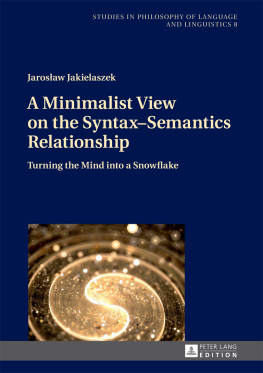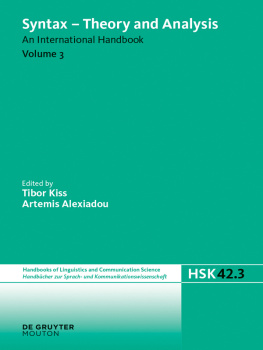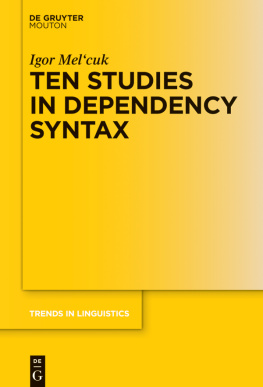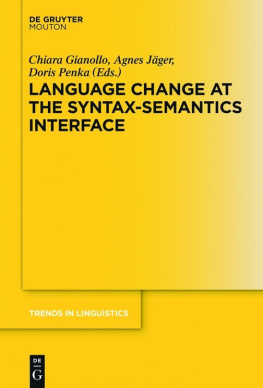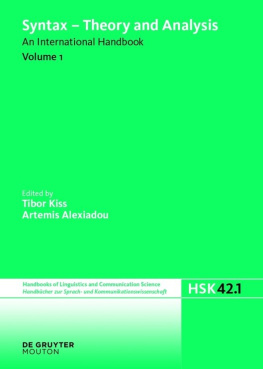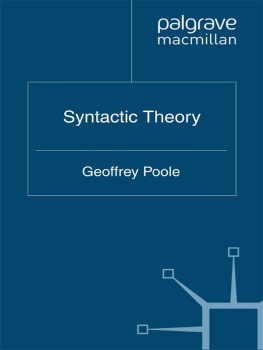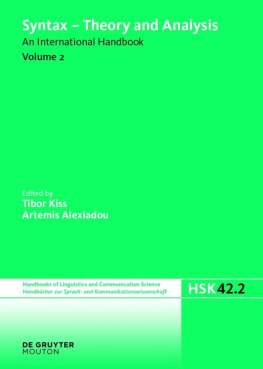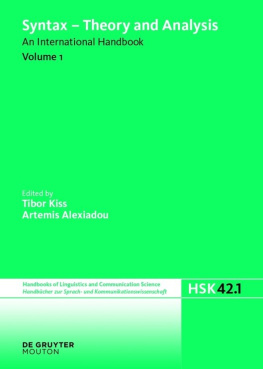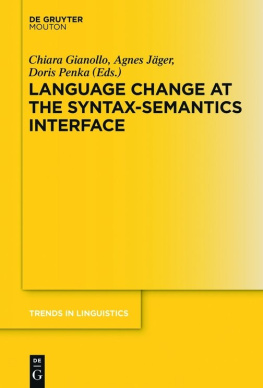Contents
Page List
STUDIES IN PHILOSOPHY
OF LANGUAGE AND LINGUISTICS
Edited by Piotr Stalmaszczyk
VOLUME 8
Advisory Board:
Emma Borg (University of Reading)
Manuel Garca-Carpintero (University of Barcelona)
Hans-Johann Glock (University of Zurich)
Paul Livingston (University of New Mexico)
Joanna Odrow-Sypniewska (University of Warsaw)
Maciej Witek (University of Szczecin)
Marin Zouhar (Slovak Academy of Sciences, Bratislava)
Jarosaw Jakielaszek
A Minimalist View on the
SyntaxSemantics Relationship
Turning the Mind into a Snowflake
Bibliographic Information published by the Deutsche Nationalbibliothek
The Deutsche Nationalbibliothek lists this publication in the Deutsche Nationalbibliografie; detailed bibliographic data is available in the internet at http://dnb.d-nb.de.
This publication was financially supported by the Institute of Classical Studies of the University of Warsaw.
Cover image:
D.Pietra / Fotolia.com
Printed by CPI books GmbH, Leck
Library of Congress Cataloging-in-Publication Data A CIP catalog record for this book has been applied for at the Library of Congress
ISSN 2363-7242
ISBN 978-3-631-65966-3 (Print)
E-ISBN 978-3-653-05411-8 (E-PDF)
E-ISBN 978-3-631-70393-9 (EPUB)
E-ISBN 978-3-631-70394-6 (MOBI)
DOI 10.3726/b10789
Peter Lang GmbH
Internationaler Verlag der Wissenschaften
Frankfurt am Main 2017
All rights reserved.
Peter Lang Edition is an Imprint of Peter Lang GmbH.
Peter Lang Frankfurt am Main Bern Bruxelles New York Oxford Warszawa Wien
All parts of this publication are protected by copyright. Any utilisation outside the strict limits of the copyright law, without the permission of the publisher, is forbidden and liable to prosecution. This applies in particular to reproductions, translations, microfilming, and storage and processing in electronic retrieval systems.
This publication has been peer reviewed.
www.peterlang.com
About the author(s)/editor(s)
Jarosaw Jakielaszek is Professor of Classics at the University of Warsaw. His research is concerned mainly with generative grammar, in particular syntactic theory, and formal semantics, covering their mutual interactions and their methodological and philosophical consequences.
About the book
Current developments of the Minimalist Program in generative linguistics put the procedure of labeling syntactic objects at the center of the syntaxsemantics transition. This book provides a discussion of consequences of such proposals for a proper analysis of different varieties of the operation Merge and their interpretive reflexes, as well as for the general theory of the syntaxsemantics relationship. It argues that the absence of substitutional operations in Narrow Syntax should restrict the range of admissible interpretive operations on adjunction structures in the conceptual-intentional component.
It also debates that syntactic chains are subject to interpretive procedures properly analyzed with the help of counterpart-theoretic concepts.
This eBook can be cited
This edition of the eBook can be cited. To enable this we have marked the start and end of a page. In cases where a word straddles a page break, the marker is placed inside the word at exactly the same position as in the physical book. This means that occasionally a word might be bifurcated by this marker.
| 7
According to one kind of analysis of de re modal talk, there may possibly be a world in which the White Rabbit is my counterpart. In that world, I would find it perfectly easy to follow Kings order: Begin at the beginning, said the King to the White Rabbit, and go on till you come to the end: then stop. Alas, that world is either spatiotemporally entirely disconnected from the actual world (if you are a modal realist), or it is merely a story (if you find ersatzism more appealing). In either case, there being a White Rabbit counterpart of me offers no help with finding an appropriate beginning for a minimalist inquiry into intricate relationships between narrow syntax and interpretive components of the C-I system in the actual world, the task being only harder if semantics is to syntax as the hole of the doughnut is to the whole of the doughnutas one may, reversing the dictum of Sige-Yuki Kuroda (see Kuroda (1979: vii)), conceive of their relationship in accordance with current minimalist views in mind. For the relationship has become more intricate on the one hand and tight on the other than it has ever been. At the outset of a story of interactions between logic and linguistics since the beginning of the 20th century, Lenci and Sandu (2009) observe:
On one hand, the rationalist turn in linguistics has actually allowed for an unprecedented convergence of linguistics with important areas of mathematical logic. On the other hand, the generative paradigm has also set constraints on the study of natural language and formulated hypotheses on its architecture that have often dramatically conflicted with the logicomathematical approach. Thus, the history of the relationship between logic and theoretical linguistics in the past decades is rather a deeply dialectic one. It is a history of profound and synergic efforts toward the common aim of understanding the nature and universal principles of human language and its formal structure, but it is also an history of harsh conflicts and divergences on the nature of universal grammar itself. At the core of this confrontation lies the issue of the relationship between grammatical form and logical form, that is to say, the possibility itself of carving out the natural language syntactic and semantic space as a logical space. (Lenci and Sandu 2009: 776)
The survey of profound and synergic efforts and harsh conflicts and divergences which Lenci and Sandu (2009) provide ends, basically, with the end of the GB period. The minimalist enterprise, while continuously stressing the importance of the relationship of narrow syntax with non-syntactic components which receive the output generated in the former and the priority of the C-I componenteither in terms of output conditions which narrow syntax should satisfy for its output to be legible at the interfaces, or by bringing syntax and the C-I component closer by taking a syntactic process, viz. labeling, to be required for 7 | 8 interpretive purposesmakes a rapprochement between formal semantics and syntactic theory even more difficult. The theoretical framework of minimalist syntax presents a desert landscape, with a constant effort to eliminate concepts and mechanisms not grounded in general computational principles as obstacles to explaining properties of the human language faculty within limits set by problems of language acquisition and language evolutionfar away from the abundance of primitive concepts and a cornucopia of mechanisms offered by formal semantics. The divergence may invite pessimism about current possibilities of both enterprises coming together:
If you look at, for example, formal semantics where an awful lot of work is done, theres no principles-and-parameters. Its assumed to be uniform and invariant. Maybe it isnt, but its assumed to be invariant. So its just like a straight, one-to-one, instantaneous mapping from syntactic structures to some kind of interpretation. And then comes the question: What are the details of the mapping? If you look at it, its kind of like phonology; it violates every imaginable computational principle. Its just not a question for people; its not the kind of question they care about. They want to get it descriptively correct, get the scope relations correct, that sort of thing. I dont want to exaggerate. There are some deep and very suggestive ideas. But I think it is fair to say that the main problems, and they are huge and challenging, tend to be descriptive at this stage of understanding. (Chomsky 2004b: 186187)

